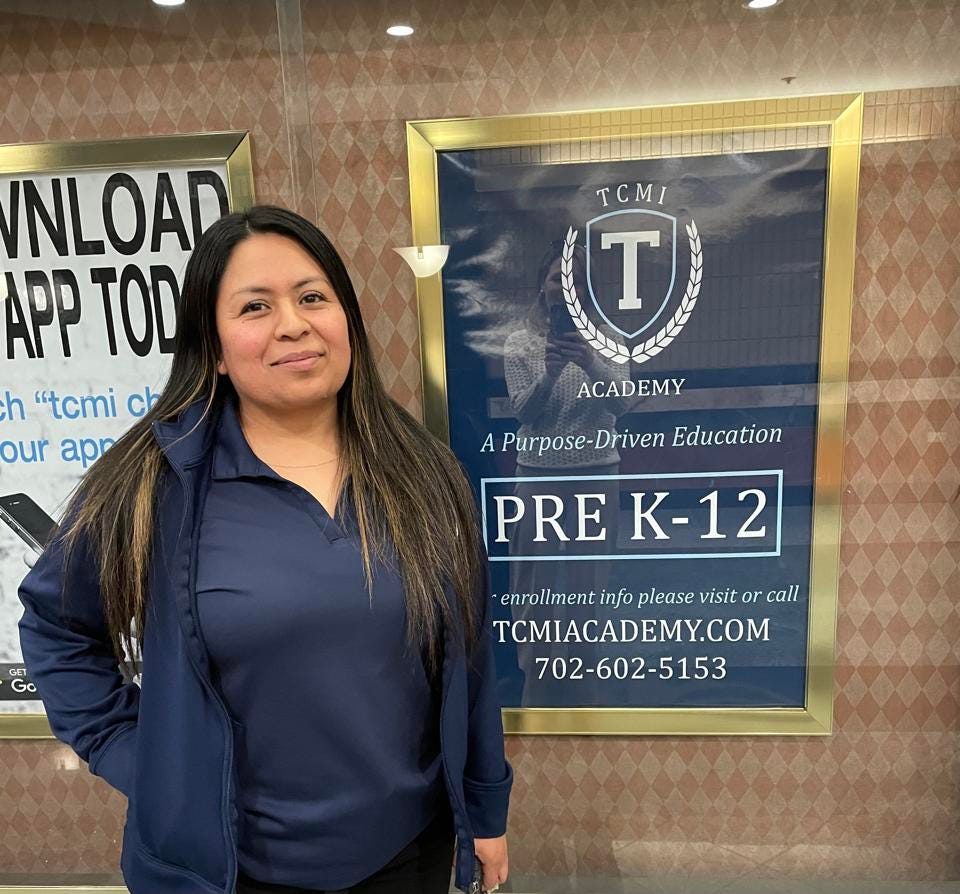
In Las Vegas, Microschools are a Winning Option
Tears filled Maria Castaneda’s eyes as she recalled moving her son from a Las Vegas charter school to a microschool in 2020. She explained that in the charter school, her 7th grader was excelling academically but was growing increasingly withdrawn and angry.
“I pulled him out because in that situation it brought out the worst of him, not the best of him,” she told me when I visited her son’s microschool, TCMI Academy.
Now in the microschool, her son has completely changed. He is happy and engaged, involved in many extracurricular activities and clubs, and has a much more open, respectful relationship with his mother. In fact, the turnaround in her son, along with his younger brother who she also enrolled in the microschool, led Castaneda to leave her job in the construction field, and take a pay cut, so that she could help with administrative tasks for the microschool.
“When I saw the change in my kids I said I want to be a part of that,” she said.
I’ve spent this week visiting some of the approximately 25 microschools within a 10-mile radius of the Las Vegas Strip, serving roughly 300 students. These microschools, or intentionally small, often mixed-age, personalized learning communities, operate either as recognized private schools or as education centers offering full-time and part-time options for homeschoolers. TCMI decided on the latter, opening with 30 full-time homeschooled students in the fall of 2020 and growing to now nearly 100 students, with a long waiting list.
The popularity of microschools in the Las Vegas valley reflects increasing interest in this learning model nationwide, accelerated by the education disruption since 2020. While microschooling has been around for more than two decades, and national microschool networks, such as Acton Academy, Wildflower Montessori, Liberated Learners and Prenda, emerged long before the pandemic, more parents are now flocking to microschools and more entrepreneurial educators are launching them.
Estimates by EdChoice suggest that up to 2 million students across the U.S. may now be learning full-time in a microschool. Additionally, a new survey conducted by the National School Choice Week organization of nearly 4,000 parents of school-age children found that many parents are continuing to seek different learning options for their kids. According to USA Today’s interpretation of the survey data: “A majority of Hispanic, Latino and Black parents – about 65 percent– said they were looking into or thinking about a new learning environment for their kids, compared with 46 percent of all white parents.”
Ashley Soifer, cofounder of the Las Vegas-based National Microschooling Center, says parents want educational environments for their children that prioritize individualized learning and student well-being.
“More and more parents are choosing a microschool for their child’s education because microschools are able to meet children where they are and customize an educational plan for each child in a way that matters to families,” said Soifer. “Parents tell us often how much of a change they see in their child once they attend a microschool: they’re happy, they’re learning, they’re thriving.”
Christina Threeton witnesses this change almost immediately. Threeton and her husband Eric, who were both longtime teachers and administrators in Las Vegas-area district and charter schools, opened their middle school microschool, Nevada School of Inquiry, or NVSI, last fall. Threeton says parents come to NVSI because other schools are draining their children of a love of learning.
“They want their children to be happy again. They want them to be smiling again, to be eager to go to school and to learn,” she said.
How long does this change usually take? “Often it’s within 15 minutes, but one week for sure,” said Threeton. She recalled the story of one mother who brought her child to NVSI for a trial day and within the first few minutes said, “That’s it. I’m driving over right now to unenroll from the other school.”
Tuition at microschools is typically much lower than other local private school options. At TCMI where Castaneda sends her sons, annual full-time tuition is $6,700, while at the Nevada School of Inquiry, annual tuition is $10,000, or less than half the cost of traditional private schools in the area. The Threetons’ microschool is licensed as a recognized private school so that they can accept funds through the Nevada Choice Scholarship Program that provides greater education choice to low-income families.
Like the microschools that are sprouting across the country, the Las Vegas-area microschools I visited are incredibly diverse. They represent a wide variety of educational philosophies and approaches, from traditional learning models and methods to more unconventional, self-directed ones. They include faith-based microschools such as TCMI and secular microschools like NVSI. This variety allows families to choose the education option that is best aligned with their individual needs and personal preferences.
One thing that is consistent and strikingly apparent across the diverse spectrum of microschools is joy. The learners in these programs, whether traditional or nontraditional, are happy, engaged, empowered and thriving. As a result, more entrepreneurial educators are planning to open microschools in Las Vegas this fall, and current microschools continue to grow as more parents hear about these programs and choose more joyful learning environments for their children.
Soifer from the National Microschooling Center expects the number of children who attend microschools in the Las Vegas area to more than double within the next 18 months, and she sees similar trends nationwide.
“This is such an exciting time for microschools,” said Soifer. “As this momentum builds, we will see more, and varied, opportunities for children to thrive.”
(Kerry McDonald is the Velinda Jonson Family Education Fellow at State Policy Network and author of “Unschooled: Raising Curious, Well-Educated Children Outside the Conventional Classroom.” This article is reprinted from Forbes magazine.)